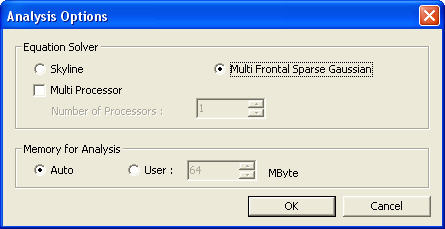Analysis Option
|
|
|
|
|
|
Assign the static analysis method and the size of RAM to be used for the analysis. |
|
|
|
|
|
|
|
From the Main Menu select Analysis > Analysis Options. |
|
|
|
|
|
Analysis Options dialog box
Static Analysis Method
Select the static analysis method to be performed. The selection of an appropriate analysis method for the size and scale of the structure affects the efficiency of the analysis.
Skyline
Band
Multi-Frontal
Sparse Gaussian
The MFSGS is especially useful for those finite elements that contain a large number of degrees of freedom.
Structures with many nodes can be solved over 10 times faster depending on the cases. The MFSGS is a particulary useful solver for the detail analysis of a structure consisted of plate or solid elements.
Note
Multi Processor Number of Processors: Enter the number of CPUs.
Note
Memory for Analysis
Enter when the analysis is to be performed using only a part of the memory in the system.
If Auto is selected, the program uses appropriate memory for the analysis after it determines the state of memory in the computer.
|
|
|
